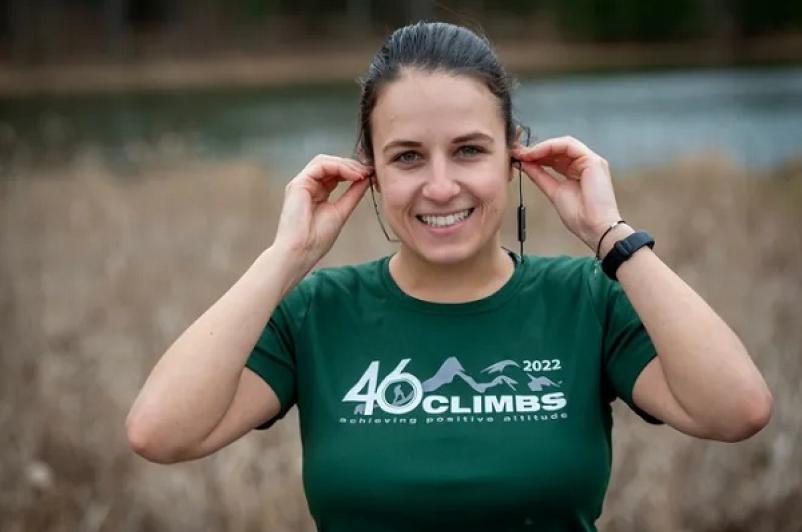

One day at a time
June 12, 2023
Emma Mucilli hurt her back when she was 19. In her job for a clothing retailer, she suffered a herniated disc while moving merchandise in the stockroom.
The injury should have been a bump in the road.
Instead, it set off an eight-year spiral of chronic pain that physically derailed Mucilli and changed how she approached life.
“I branded myself an injured person,” Mucilli says. “I woke up every morning, and the first thought was, ‘How much pain am I in today?’ I used that pain gauge to dictate everything I did for eight-and-a-half years.”
She saw lots of doctors. She tried physical therapy several times with only fleeting success, falling back into pain and frustration. One day in early 2022, while meeting with UHS pain-management specialist and orthopedic spine surgeon, Matthew Bennett, MD, she broke down crying.
“I hit my breaking point,” Mucilli says.
There are two ways to respond to a breaking point. One is to break—to give up. The other is to change course, and that’s what Mucilli did, deciding to pursue her healing with a singular dedication.
Bennett recommended giving physical therapy one more try, this time with a therapist who specialized in spinal injury. So Mucilli drove from her home in Binghamton to a UHS clinic in Owego, hoping for a different result after years of constant pain.
REFRAMING THE MINDSET
When the new therapist, Kelly Buchsbaum, a physical therapist specializing in spine care and sports medicine, met Mucilli, “You could see that she had this amazing spirit and passion, but that her spirit was dampened by her pain and the fact that she couldn’t get better,” Buchsbaum says.
What followed was a mix of traditional physical therapy, such as correcting Mucilli’s gait and strengthening underused muscle groups such as her glutes and abs, along with treating the psychological aspects of chronic pain.
“A lot of times chronic pain almost incapacitates people because they become very fearful of movement,” says Buchsbaum. “They’re trying to protect themselves and have stopped doing what they like to do because they think it’s what’s causing their pain. But movement—proper movement patterns—is what we have to get them back to doing.”
Mucilli was stuck in a cycle. On days when she felt good, she would cram in runs, ski trips and 12-mile hikes with her dad. Then her pain would flare up in response, and she wouldn’t move for a week.
To truly recover, Mucilli had to learn to take it slow on the good days. She also had to learn how to process the twinges of pain she would feel during her recovery. Meaning, not every sting or ache meant she was reinjured and needed to rest. Sometimes, those sensations are part of the recovery journey.
“Now, if my back does twinge, I think to myself, ‘Hey, I’m not injured. This isn’t harmful, so let’s keep going on with the day,’” Mucilli says. “When I do, the twinge goes away.”
Buchsbaum also introduced Mucilli to other partner clinicians, where Mucilli was examined simultaneously by Buchsbaum, Bennett and UHS Chiropractor Douglas Taber, DC. One breakthrough came when Buchsbaum referred Mucilli to a running-shoe store, and she was fitted with shoes that improved her gait by correcting her tendency to pronate or place most of her weight on the inside edge of the feet.
“A really good pair of sneakers made a huge difference for her,” says Buchsbaum.
Mucilli could sense that she was making real progress, and her excitement grew. That’s when Buchsbaum had to put on the brakes, encouraging Mucilli to literally apply the adage “Walk before you run.”
Mucilli loves to run and was itching to hit the pavement during the summer of 2022. But Buchsbaum encouraged her to stick to a walking program instead, to avoid setbacks associated with doing too much too soon.
“It’s definitely a mind game, especially when you’re trying to get back to something really
important to you, and that’s a higher-level activity like running,” Buchsbaum said.
WHERE THE LONG ROAD PAYS OFF
Eventually, Mucilli got her therapist’s blessing to begin running again about five months after starting therapy and has continued progressing. On a sunny day in early February, she ran three miles and then spent the rest of the day taking a mental inventory of her body to see if there was residual pain.
There was none.
That was a landmark moment for Mucilli, though not her favorite part of recovering from chronic pain.
“I feel like my relationships with other people are just flat-out better,” Mucilli says. “I’m able to have more patience, compassion and empathy.”
It’s a triumphant season for Mucilli. For Buchsbaum, watching Mucilli’s progress has been both thrilling and validating in terms of the impact that therapy can have.
“It will never stop being amazing when you’re able to really get through to a patient that they can reach whatever their goals are,” Buchsbaum says. “With chronic pain patients, that doesn’t always mean getting rid of all of their pain. But it can mean getting their life back.”
TAKING CONTROL OF YOUR PAIN
For more information about physical therapy or spine care and pain relief at UHS, head to NYUHS.org.

